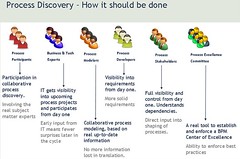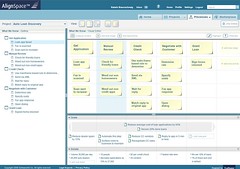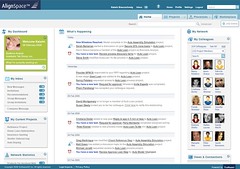 A couple of months ago, Software AG launched AlignSpace, a social BPM community, and gave a webinar to explain what it’s about (replay here). AlignSpace is intended to be a vendor-neutral place where people doing process discovery can share ideas and collaborate on process discovery. Gartner estimates that over 40% of BPM project time is spent on process discovery, which is inherently a collaborative activity including everyone from process participants through developers and a BPM center of excellence, but there aren’t a lot of great tools out there to do this.
A couple of months ago, Software AG launched AlignSpace, a social BPM community, and gave a webinar to explain what it’s about (replay here). AlignSpace is intended to be a vendor-neutral place where people doing process discovery can share ideas and collaborate on process discovery. Gartner estimates that over 40% of BPM project time is spent on process discovery, which is inherently a collaborative activity including everyone from process participants through developers and a BPM center of excellence, but there aren’t a lot of great tools out there to do this.
Software AG looked at a lot of social media sites to understand the key features that people want when working together online, and created a cloud-based platform where people can capture process requirements and model processes. This is intended to be beyond what Lombardi is already doing with Blueprint, where people can collaborate on create a specific organization’s process models, and create the potential for a marketplace as well as a collaboration platform.  That being said, their initial process outline view has a lot in common with Blueprint, with stages/milestones comprising activities, and the way that can be also visualized as a process map. You can import a model from Visio or XPDL for sharing in AlignSpace, then export it back out again. They also have a home page that shows what’s happening in processes in which you’re involved, and links to your contacts on other social sites.
That being said, their initial process outline view has a lot in common with Blueprint, with stages/milestones comprising activities, and the way that can be also visualized as a process map. You can import a model from Visio or XPDL for sharing in AlignSpace, then export it back out again. They also have a home page that shows what’s happening in processes in which you’re involved, and links to your contacts on other social sites.
The AlignSpace Marketplace is intended to be able to find or document BPM resources, whether people or products/models, then allow participants to rank those resources for others to see.
They’re still in a closed beta, but you can go there and sign up to participate. AlignSpace will be free to use, and although vendor-independent, it will be launched with a library and community of resources (some of which will, necessarily, have particular vendor expertise). There’s some lightweight Software AG branding on it, but it’s not their intention to block anyone from it: it’s really intended to be an open BPM community. I give them a lot of credit for this, since most of the other BPM communities launched by vendors are very much specific to their own products, which is going to stifle a lot of good discussion. Software AG seems to recognize, even in these economic times, is that a rising tide floats all boats: if more people are interested in BPM, and AlignSpace helps to get them over the initial barriers of adoption, then all BPM vendors will benefit. Outside the BPM vendor-specific offerings, there are definitely other collaborative workspaces and social networks around, but few with a BPM focus.
 Security is obviously going to be a serious consideration: even though most companies don’t put customer data in their process models (as opposed to the executing processes), the processes may represent intellectual property that provide them with a competitive advantage. They are looking at corporate-restricted versions, such that only users from within your domain can access it; the same sorts of security measures have already been put in place in Blueprint, and you can be sure that other cloud solutions are going to have to solve the same problem.
Security is obviously going to be a serious consideration: even though most companies don’t put customer data in their process models (as opposed to the executing processes), the processes may represent intellectual property that provide them with a competitive advantage. They are looking at corporate-restricted versions, such that only users from within your domain can access it; the same sorts of security measures have already been put in place in Blueprint, and you can be sure that other cloud solutions are going to have to solve the same problem.
They have ambitions to move this beyond BPM and provide a collaborative space for discovery/requirements for other sorts of IT projects: a bit like ConceptShare, but with more of a focus on technology implementations rather than media and design.
I had a chance to talk to Miko Matsumura of Software AG around the time of the initial AlignSpace announcement; he admitted (which is what I love about Miko) that initially AlignSpace is a lot of big ideas but not much delivered. Like Google with its betas, the idea is to get something out there for people to use, then use their early feedback in order to decide what gets added in next. Although they’re trying to focus on “data format promiscuity” in order to allow customers from many BPMS vendors to participate, the process models are publish and subscribe rather than an interactive whiteboard model in their BPM sketchpad. The big focus is on creating fertile ground for the concept of collaborative process improvement, pulling together innovators from across multiple organizations and infecting companies with process innovation. Data formats are only one issue, as he points out: there is as much tribalism and heterogeneity in the people issues as in the systems that they use, and we need to get the tribes to disband, or at least come to a neutral territory.
From a social media standpoint, the AlignSpace presence doesn’t get full marks: their blog hasn’t been updated since June, their Twitter stream is mostly links to other BPM resources rather than any original material or updates on AlignSpace, and on Facebook they have both a group and a page, without a clear distinction between how each is used.
This all sounds great, but as yet, I haven’t seen the beta. Yes, that’s a hint.

My take runs, perhaps, against the “mainstream” on this. For starters, creating open, collaborative process discussions, particularly in the unstructured environment of social networking is plain and simple a recipe for disaster. We’ve done this before (though not with social networking software) and it’s like the old saying, too many cooks spoil the pot. Having personally been cooked several times in using the “get everyone involved” collaboration approach to process I can vouch for how quickly it turns into a mess that is tangled enough that it becomes very hard to extract one’s self from it.
I’ve also done this in workshops and in most cases for each person above a group of 3 added to a process improvement activity, the work takes twice as long and is far more likely to have less attractive results. I can’t even imagine what might come from something like this if it actually gets some serious traction but I know it’s not pretty.
Also interesting to note that the “idea” is to learn from those who join and interact with the site, which reinstates the fundamental issue with BPM vendors – that they do not understand customer needs. I have no doubt that the BPM challenge is one of embedded expertise in product, not core engine features and functions or in the sharing of opinions on a social networking site. All that will do is create even more confusion as there is no filter on content quality and group consensus is NOT a substitute for expertise.
Terry Schurter
I am intrigued as to how a meaningful process improvement project could be achieved with 3 (or less) stakeholders (or ‘personas’ to use your employers vernacular). Given we all agree that business and IT have to be represented, I guess that covers two of them!
Are you really suggesting that we should take a dictatorial approach to process improvement and that only the opinions of a few appointed ‘process experts’ should count?! That’s definitely an interesting approach to innovation.
We are not talking about a solution that allows decisions to get taken by some sort of group concensus here. Instead we are talking about a mechanism that allows us to find and harness the minds of the informed and feed it into a structured framework for decision-making. It’s a platform where project owners still retain control over who and what is involved in their initiatives.
Just because we are using social networking as a feature of AlignSpace does not make the approach unstructured. Social networking offers nothing more than a way of connecting with people that have a relevant perspective, and a collaborative platform allows these people to contribute in a more productive way. Certainly more productive, than the unscalable, 3 person, closed workshop approach that you would seem to recommend.
Finally, comments like “[BPM vendors] do not understand customer needs” are frustrating to say the least. Especially so when they are made by someone who recently accepted a senior position at one such vendor. Is it really possible that businesses such as Software AG and Global360 could be successful if they didn’t have some understanding of what their customers needed? Are we *so* good at sales and marketing that, in the current environment we can get our customers to part with money for solutions they don’t need?
I personally think the persona approach that Global360 is advocating shows that you *do* understand your customers….I just think there are more than 3 ‘personas’ that we need to be listening to!
Mike Lees
I’m supposing that Terry means that the “authors” of the process (drivers, authors etc) need to be a relatively small number of people.
However, I’ve found that the Bus Brake Effect only takes over if you let it. You have to keep the larger audience from dragging you into oblivion. It can be done and in fact it is accomplished all the time 🙂
Mike, you make some great points about the value of broader participation.
Sandy, do you intend to complete the series and review the other “collaborative” offerings?
Taking a social approach to BPM is fascinating and seems to be in line with the way people actually work in BPM projects. I would not say that I am a BPM expert but have participated in half a dozen such projects. The projects seem to take the same route; they start with the “smart” people and then they have to invite the “right” people to participate. It is rare that the initial people in the project are, in fact, the ones that have all of the information needed to complete it. The team inevitably ends up reaching out to others for assistance. The interaction paradigm that social networking gives has the potential to revolutionize the way these projects go.
Unlike Terry, I don’t believe that social groups have to be unruly. I am a long time Facebook user (http://www.facebook.com/jessiekeen) and routinely use it to organize meetings and projects. While there is a huge potential for disorganization in such settings I have found that eventually a clear hierarchy develops. Most social media users only really participate when they really have to. Most of the time they are in “view only” mode. I suspect that this is what will eventually happen to AlignSpace projects. In the long run social networking is very much like being there in person. There are leaders and there are followers; most are followers.
While I think that the social approach to this is interesting I am also very intrigued by the “marketplace”. Being able to have easy access to “community” BPM resources is a fantastic idea. How will this be populated? By the community? What can be shared? I love the voting aspects which really bring the community into the picture.
Sandy thinks for bringing this to light.
with recent acquisition of ARIS stack (IDS scheer), i think that BPM will go in the cloud …
Nice article so i suscribe to bcome an e betatester ..
Scott, I do intend to take a closer look at IBM’s Blueworks now that it’s open for business. Interesting to see the different vendors’ takes on inter-company (or even intra-company) collaboration.
@Jessica
We are currently talking to various people in order to get some contents for the marketplace before it launches. However, the idea is that the community drives it once it is available. BPM experts/consultants/vendors/etc. will be able to advertise their services by posting a portolio. In addition to that we hope that people will share reference processes or process templates – maybe even reference projects that include more than just a process model.
– Thomas
A few points of clarification may help to place my comments into better perspective. One – we do NOT all agree that IT has to be involved in defining the scope of an improvement. Two – including other people (as Jessica described) is very often necessary. That does not make them part of the “improvement team” though. In fact, if the right questions aren’t poised to the right people the wheels can come off of that as well. Three – sure, with a solid team leader the group can be larger… assuming that is the case. Four – it also depends on the problem we are seeking to solve. If we are developing automated processes (I would call them business services) than best practice sharing is spot on. If we are dealing with processes rife with human interaction, I stand on points already made. Five – yes, I am hard on BPM vendors. That is because we’ve only scratched the surface of what we can really do with BPM. Incremental improvement is all fine and dandy, but the opportunities for 20% – 50%+ cost reduction, productivity enhancement, revolutionizing customer service and so forth exist in almost every organization. Making BPM part of truly transformational business is the opportunity that I don’t think BPM vendors “get.” That said, I obviously wouldn’t be where I am if I didn’t think there was an opportunity to flip that on its head.
So if AlignSpace is intended to be a forum for business services (automated processes) then kudos – it should be very valuable. If it is intended to foster a broad conversation on human-centric processes then every consultant that has a BPM shingle out will probably love it as a means to build profile and create affinity with potential customers (I’m not disparaging consultants by the way). I don’t see that addressing the real opportunity, but it ought to do well.
For customers, BPM vendors have yet to step up to the plate and really unravel the key challenges. You can’t do that by asking customers what they want. That’s not how Skype came into existence, how Zara became the largest fashion retailer in the world, how Apple designed the iPhone or how Discount Tire reshaped the entire US tire retailer market. You can’t do that without solving problems that haven’t been solved before. For SAG, Mike, I would expect your focus will tend towards the more technical side of BPM (you are working for a German company now). My comments may be more a reflection of focus or perspective than anything else. Oh, and sorry to create frustration but in the world of BPM technology I’ve been living with it for years!
Terry Schurter